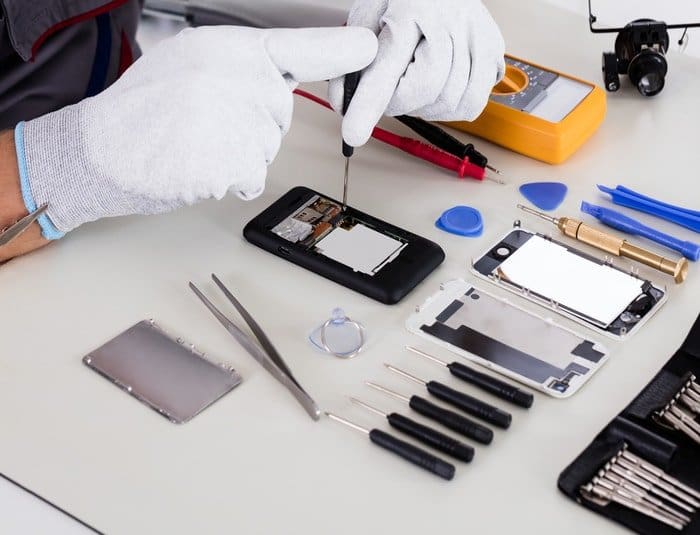This article is all about starting a cell phone repair business that’ll blow all the other repair shops out of the water. Once you start your repair business, you’ll be able to tap into this lucrative customer base.
And then, as far as earning potential goes, THE SKY’S THE LIMIT!
To ensure that this article contains the most up-to-date information about cell phone repair, I talked to Joe Pilat, of Joe’s Gaming & Electronics located in Deming, Washington. He owns a business that buys, sells, and repairs brand name electronics—including cell phones.
The name of his business is Joe’s Gaming & Electronics. In just three short years, he turned his business into a multimillion-dollar empire with 30 employees. Here’s a photo of him and his team:

Joe’s Story
Joe began his entrepreneurial journey eight years ago. That’s when a buddy of his gifted him a Game Cube. He tried to sell it to Game Stop, but they only offered him a measly five bucks for it. Joe knew he could get more than this pathetic amount. So, he went home and created an Amazon account to sell the game console.
Joe quickly found a willing buyer. Although he lost money on the deal because shipping cost him more than he made, Joe still got more than he would have at Game Stop. That single transaction turned him into a raving eCommerce addict.
This utterly transformed his life!
Next, he bought a whole bunch of Nintendo merchandise on Craigslist. That led to him buying more stuff he could flip for cash. His cell phone started blowing up with endless payment notifications, and he soon had a highly profitable business on his hands.
Within two years, he was able to quit his day job. He also dropped out of college, because the experience of selling consumer electronics provided him a real-life educational opportunity college could never compete with.
Starting a cell phone repair business really isn’t that complicated.
You just need the right tools, some basic repair skills, and a killer marketing strategy.
So, what are you waiting for? Let’s get started, so that you too can follow the exact same steps Joe followed to create his own multimillion-dollar cell phone repair business! If you want to watch our interview with Joe, you can do so right here:
Follow this step-by-step guide to get more information.
Step 1: Come up with a cell phone repair business plan.
Joe didn’t follow this step. When I asked him about it, he said:
However, you might want to make sure you create one. A business plan takes a vague idea floating around in your head and gives it solidity. It helps ensure that your business model is a viable one. It can be a formalized, highly complex document. Or, it can be a short, outline scribbled on the back of an old envelope.
Here’s what one looks like:

Start by figuring out who you’re writing it for. If you’re pitching for investors, include things like return on investment and your exit strategy. If it’s for your own use, you can leave this stuff out.
Here are some of the sections you might want to make sure you have for your cell phone repair business:
- EXECUTIVE SUMMARY: This is an expanded version of your elevator pitch, and lists all the reasons you’re writing your business plan. The executive summary is the first thing interested parties will see, but it will be the very last thing you write. Readers will either be captivated by your idea and want to read the rest of the plan, or, they’ll get bored and won’t.
- BUSINESS DESCRIPTION: This is a concise overview of your cell phone repair business. What is it about your business that’ll make it a runaway success? Describe, in excruciatingly exact detail, how your company is uniquely positioned to meet customers’ needs.
- OWNERSHIP: This is how you’re going to structure your cell phone repair business. When you’re starting out, you’ll probably be organized as a sole proprietorship.
- MANAGEMENT AND ORGANIZATION: Who’s running the day-to-day operations of your repair business? Write about the experience of each person running the company, including you–the owner. Interested parties are going to want to know how each team member fits into the organizational structure.
- MARKETING: How do you plan to promote your cell phone repair business? Write about your marketing strategy and how it’ll drive more customers through the door. Whether it’s by word of mouth, social media, or something else, it’s important to plan it out.

- MARKET ANALYSIS: Here’s where you list five similar repair shops and evaluate how they stack up to your own. Rigorously evaluate your competitors, describe the industry you’re working in, and provide a little info on your target demographic. A fantastic thing to do is to list five repair shops similar to yours and how they stack up.
- OBJECTIVES: How will you know when your repair business is successful? You won’t know that unless you establish specific metrics.
- TARGET MARKET: Who’s your ideal customer? List all the attributes you can think of that make up customers you’d think you should be targeting. This is known as a customer avatar.
- FINANCIAL PROJECTIONS: Here is where you take your objectives and translate them into figures backed by hard data.
- REQUEST FOR FUNDING: Include current and future funding requests, so investors and lenders will know how much debt you’re potentially taking on.
- FINANCIALS: Here’s where you’d put your financial projections. Normally, they’ll want to see past financial data, but since you’re just starting this company, that documentation is most likely nonexistent.
Step 2: Make real-world experience part of your education.
College might not be the best choice for people who want to be entrepreneurs.
That’s because entrepreneurs learn best by actually doing things. To become a top-notch business owner, hone your skills by perfecting them out in the real world.
Ever since that momentous day when he decided to pursue his ambitious dreams, he’s acquired a world-class education without going to college while making TONS of cash in the process.
Step 3: Get some equipment and supplies.

If you’re starting a cell phone repair business from scratch, you’ll need some tools. Try to not waste money on cheap ones because they’ll only end up breaking. Joe uses Hakko for all his soldering equipment. As for other types of tools, see what repair industry professionals recommend and buy those.
As you grow your cell phone repair business and have a little more money in the bank, you’ll be able to afford fancier tools to do fancier repairs with. A piece of equipment might cost several hundred dollars. But if it lets you do cell phone repairs many competitors can’t do, it becomes an excellent investment.
Step 4: Acquire the necessary skills.
Starting a cell phone repair business doesn’t require an expensive college degree or a formal training course. Sure–you can go to a cell phone repair school or a technical institute, but you don’t have to. That’s because everything you need to know about mobile repair you can learn from YouTube videos.
That’s how many cell phone repair shop owners began their entrepreneurial adventure. It’s an incredibly easy way to get started!
Here’s what Joe had to say about skills:
Step 5: Find a location that’s right for you.

When you’re starting a business, you can always run your cell phone repair shop out of your home. That’s what Joe did. He first operated out of his bedroom, then his parent’s garage. What’s great about working from home is you don’t have to shell out a single dime for rent.
There might come a point when you’ll want a repair shop that’s separate from your residence. This could happen if your cell phone repair business gets way too big to operate out of your garage or bedroom.
If you’re going to have walk-in traffic for your cell phone repair business, make sure you find a place that’s convenient for customers to get to.
If you’re only doing mail-order business like Joe does, this won’t be a factor.
Step 6: Assemble a team of dedicated ninjas.
When you’re just starting out with your cell phone repair business, you’re probably going to be a company of one.
However, there might come a time when business is booming so much, you have to bring on additional employees.
If you want your cell phone repair business to skyrocket to stratospheric heights of success, forge partnerships with people who have a singular passion for your company’s mission. These are the guys (and gals) who are going to make all the work happen. So, make sure you’ve given them everything they need to be resoundingly successful.
Employees who have a passionate intensity for the work is vastly more important than employees who have skills. Here’s Joe again:
Step 7: Fund your business with your profits.

You only need a shoestring budget to fund a cell phone repair business because you only need a minimal amount of inventory and tools. Here’s Joe again on how he funded his own company:
Step 8: Create an effective marketing strategy.
Experiment with different marketing strategies for your cell phone repair business and come up with one that’s effective. In Joe’s case, his plan has continuously evolved over the years. His current approach is to let the work speak for itself. He does this by having hundreds of YouTube videos showing people how they can repair their own cell phones and other devices.
His company has lots of tutorials on how to repair iPhones and other cell phones, Xboxes, wireless earbuds, and so much more. Viewers can purchase the parts and tools they need to complete the repairs. This organic funnel has dramatically increased business revenues.
Create a brand identity.

You need to create a brand identity for your cell phone repair business with an eye-catching logo and a compelling description of what you’re all about. Many business owners think that coming up with a company image is only for such corporate behemoths like Walmart, Apple, and Coca-Cola.
This is outdated thinking!
These days, even a small business can benefit from creating brand awareness so powerful, it gets customers to sit up and take notice. By making the customer aware of what value they’ll derive from your service, you’ll give your brand awareness an extra “oomph.”
Joe brilliantly uses his website to build brand awareness. For example, it’s visually elegant, with only two colors that provide an attractive simplicity that draws people in without overwhelming them.
His “About” story is folksy and humorous. I love these words from his “About” page:

This kind of language puts a human face on his business. As human beings, we have an intense desire to deal with fellow humans, and not companies that sound emotionless and robotic.
Step 9: Start out organized and stay that way.
For Joe, starting out organized and staying that way is the only way to operate a repair shop at optimal levels of efficiency.
In Joe’s shop, everything is organized to the nth degree. There are QR codes everywhere you look—even on the garbage cans! If you want to learn the most efficient way to do something in Joe’s business, all you have to do is to scan a code.

Then, a video pops up showing you the best way to do that task!
Joe put something called a “Kanban card” in every box of parts. “Kanban” means “signboard” or “billboard” in Japanese. Joe and his employees place these Kanban cards exactly at the point in the box when more inventory needs to be reordered. An employee scans the QR code on the card, the vendor receives the order, and more stock is on its way.
By using a system like this in your cell phone repair business, you’ll never run out of inventory. Never running out of stock means you’ll always have a steady supply of cell phone repair parts to make sure you fulfill customers’ orders.
Step 10: Learn to delegate.
One of the most significant challenges Joe faced in his entrepreneurial career was learning how to delegate. It was difficult for him to realize that he couldn’t do everything by himself–that he needed a team of dedicated ninjas he could trust to help him carry out his mission.
If you want your cell phone repair business to be successful, you’re also going to have to learn how to delegate. When your business grows to the point where you have a whole team of employees, you’re setting yourself up for failure if you continue to do tasks that are better handled by others.
So, trust your team to help you carry out your mission.
Step 11: Have a guiding philosophy that permeates every aspect of your repair business.

Learning about the way Paul Aker uses the Lean philosophy was a life-changing experience for Joe. Lean creates efficiency while eliminating waste. Paul took a concept practiced by many of the world’s top companies and made it easy for the average guy on the street to understand.
Joe uses the Lean philosophy to try to gain ten-second improvements every single day. He’s got a sign in his cell phone repair shop that beautifully says it all:
People who want to work for Joe must first listen to Paul’s book, which is free on YouTube. This weeds out those who have a burning passion for improving themselves from those who don’t. If the prospective employee comes back after four hours (which is the length of the book), super excited to work for his repair company, Joe knows that person is a good fit.
That’s because Joe knows that this individual possesses the energy and drive that’ll make that person an indispensable asset!
Step 12: Understand the market you’re servicing.

Joe considers this to be one of the most important things you can do to make your business successful.
He says if you focus more on what the customers want, and less about what you want, you’re going to have a profitable cell phone repair business. You need to understand the consumer—what are they willing to pay for, and how much are they’re willing to pay for it. Once you determine that number, it’s going to be a lot easier to know what value you have in the marketplace. This will make you SO much more confident about your marketing efforts.
This is the way Joe puts it:
Step 13: Always stay one step ahead of the competition.
As the owner of a cell phone repair company, you need to always be looking for ways to beat your competitors.
Here’s what Joe has to say about that:
For the last three years, his cell phone repair company has been feverishly working on software that automatically sends a shipping label to a customer. The customer can then send his item to the repair center for free from anywhere in the United States. This provides the customer with an end-to-end solution, and they love that.
This has allowed their mail-in center to grow its revenues fifty times what they were before.
Although this software has exponentially increased the efficiency of its operation, this system can be replicated by many other repair businesses. However, Joe’s cell phone repair company is leading the pack when it comes to making the customer experience as easy and enjoyable as possible.
Step 14: Create more income streams by adding more services to your existing ones.

You might find yourself hitting a profit ceiling if repairing cell phones to good working order is the only service you offer. If that happens, think about branching out from cell phone repair and offer other things to your customers. For example, you can be like Joe, who, in addition to cell phone repair, fixes Fitbits, speakers, headphones, iPads, and more.
Step 15: Learn from your mentors.
Joe always looked up to his dad, who had a side business installing HVAC when Joe was just starting on his entrepreneurial journey. When his father turned 55, he decided he was done with his regular job. He then made his side hustle his full-time work
Joe took inspiration from this and decided to do the same thing. Joe’s father’s hard work and determination showed him how incredibly rewarding these traits could be in business.
On a more strategic level, Paul Akers was a tremendous help for Joe. Lean manufacturing powerfully transformed Joe’s cell phone repair business. Joe knows that incremental improvements lead to lasting success, and Joe’s company has greatly benefited as a result. We highly recommend that you watch Part 1 and Part 2 our interview with Joe on the topic of lean manufacturing. Here’s the preview of it below:
Step 16: Be persistent.
The first thing you’re going to have to do is to when starting a business is to work on your mindset so that you’re like the T-1000 robot from Terminator 2. This was the prototype Terminator sent by Skynet and made from something called a “mimetic polyalloy.”
This formidable liquid metal monstrosity relentlessly pursued Arnold despite having numerous obstacles thrown at him. And even when Mr. Schwarzenegger blasted the entity into a trillion nanoparticles with his trusty 1887 Winchester 12-gauge shotgun, the mechanical shapeshifter always managed to put himself back together again. This is the kind of determination you’ll need to have if you want your cell phone repair business to be a smash success.
Here’s how Joe puts it:
What’s the downside of a cellphone repair business?
- THIRD-PARTY LIMITATIONS: Many cell phone brands won’t let a third party business repair their stuff. However, Apple allows independent repair shops to repair out-of-warranty iPhones if they have an Apple-certified technician on staff. The only problem is that new phones are off limits, and the certification is expensive.
- LOCATION ISSUES: If you’re working from home, there’s going to be distractions galore, so you won’t get as much done as you would working at an office. On the other hand, if you work out of a dedicated storefront, you’ll be incurring a mortgage or lease expense.
- MARKETING EXPENSE: If you’re not careful, marketing costs can quickly add up. Billboard and radio ads, mass mailings, and Google AdWords can be expensive. If you’re creative, you can effectively market your cell phone repair business with little money—you can even start on a shoestring budget.
- EQUIPMENT COST: When you’re just starting out repairing cell phones, you’ll have to buy some basic equipment. While some stuff is cheap, other stuff can be quite expensive.
How much does a cell phone repair business make?

How much you make depends on how many cell phone repairs you can do and how good your supply chain is. However, many cell phone repair businesses have HUGE profit margins.
When you start a cell phone repair business, you might see a profitability rate between 80 and 100%! If you charge an average of $75 per repair and do 15 repairs each week, your weekly gross earnings will be $1,125. With an 80% margin, your weekly profit would be $900.
Not too shabby!
There are also cell phone accessories to sell, which will increase your bottom line even more. Of course, if you’re ambitious like Joe, you can scale your business to stratospheric heights. Then, there’s no limit to how much you can make!
Is mobile repair a good business?
Joe got into business because he loves to help people. Here’s what he has to say about that:
If you provide your customers with impeccable service, assemble a team of employees who care deeply about your company’s mission, and establish good procedures, chances are good your repair business will be successful.
Get started now with your cell phone repair business, and you too can scale to unimaginable heights!




